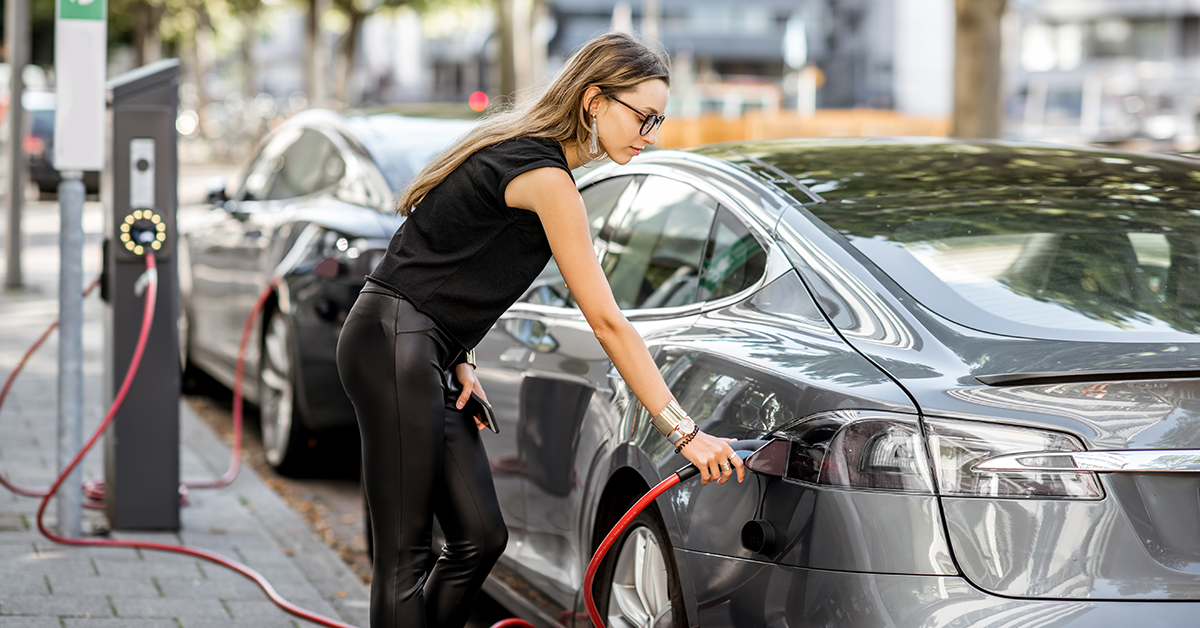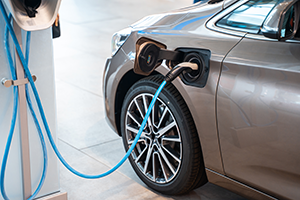Our 2025 Sustainability Report is here! Dive in.
Harnessing the Distributed Energy Resource Capabilities of Electric Vehicles
June 8, 2020 •Franklin Energy

The electric vehicle (EV) market has been experiencing significant and sustained growth in recent years as drivers seek to cut their carbon footprint and reduce gas costs. While EVs still make up a relatively small share of the automobile market, that’s expected to change within the next few years. By 2025, it’s estimated that EVs will account for 20% of new car sales.
The fuel and maintenance savings realized by EV owners when switching from an internal combustion vehicle to an electric vehicle are well-documented, as are the societal benefits associated with zero tailpipe emissions. However, one benefit EVs provide that is often overlooked is the financial benefit all utility customers experience for each new EV served by their utility. A large municipal utility in Texas recently reported that due to the increased sales associated with EV adoption, every EV added to their system has reduced the need to collect $385 dollars from their current customer base. These savings alleviate the need for new rate increases that impact all customers. However, for these benefits to be realized, customers must first be comfortable and confident in electricity as a fuel source for their next vehicle—although this may be a difficult task, as indicated by a recent AAA report which found that 60% of Americans are either “unlikely” or “unsure” about purchasing an EV. Within that group, 57% reported their primary concerns as finding places to charge and running out of charge while driving.
This hesitation has driven many utilities to focus their first EV program initiatives on providing customers with EV charging education resources. These resources focus on providing customers with a single place to find rich amounts of easy-to-consume information on electric vehicle makes and models, home charging options and costs, and the local availability of public charging infrastructure. When executed well, these resources strengthen the utility’s relationship with customers, improve customer satisfaction scores, drive new enrollments in program offerings, and most importantly, increase EV adoption and kWh sales for the utility.
As EV adoption increases its unique impact on each utility’s system, both positive and negative outcomes start to emerge. The increased kWh are a welcome change, but it becomes critical to manage the timing of kWh flowing into vehicles, in order to ensure the costs don’t outweigh the benefits. This is where the DER capabilities of EVs come into play. Reducing the cost to serve EVs is best achieved by presenting customers with off-peak and managed charging programs. These programs provide customers with rate discounts for charging during specific hours, often in the middle of the night or middle of the day when cheap excess generation exists. Concentrating EV charging into off-peak hours can be done in a handful of ways, including the following.
outcomes start to emerge. The increased kWh are a welcome change, but it becomes critical to manage the timing of kWh flowing into vehicles, in order to ensure the costs don’t outweigh the benefits. This is where the DER capabilities of EVs come into play. Reducing the cost to serve EVs is best achieved by presenting customers with off-peak and managed charging programs. These programs provide customers with rate discounts for charging during specific hours, often in the middle of the night or middle of the day when cheap excess generation exists. Concentrating EV charging into off-peak hours can be done in a handful of ways, including the following.
Active Managed Charging Programs provide financial incentives to customers for allowing the utility to control the vehicle’s charging equipment or the vehicle itself. Incentive structures vary and are typically linked to customer event performance (kW or kWh reductions) and maintaining an active enrollment status. Technologies leveraged for active charging programs primarily include load control switches, networked “smart” charging stations, and/or direct communication with the vehicle. Active managed charging programs are the only choice for utilities seeking to tap into the more complex DER value streams EVs can provide, like frequency response, spinning reserves, and other ancillary grid services that require an automated rapid response.
Passive Managed Charging Programs present customers with financial incentives for modifying their charging behavior own their own. To do this, dynamic rate structures like time-of-use rates, peak-time rebates, and/or critical peak pricing periods are deployed to send clear price signals on when and when not to charge. These programs differ from active managed charging programs in that customer participation is completely voluntary. Power is always available to the customer’s charging equipment and program effectiveness relies not on stable communications to devices but on impactful communications to customers.
Regardless of the method utilized, eliminating the need to serve these large loads during peak periods allows utilities to benefit from increased sales and reduce the need for new investments in generation resources and distribution infrastructure—meaning a larger portion of savings can be realized by all customers.
In the future, it is envisioned that EVs will also function as DER by acting as dispatchable battery systems connected to the distribution system, reducing strain on the grid by feeding energy back into the grid when needed. In fact, an EV with a modestly sized 30 kWh battery can store as much energy as the average US household uses in a day.
 According to a 2017 report by the Rocky Mountain Institute, EVs have enormous potential as grid suppliers. “With appropriate vehicle-to-grid (V2G) technology, EVs can function as grid supply—serving the same functions as power generators—as well as being grid loads,” the report states. “EVs could pump electricity back onto the grid at times of high demand and participate in the ancillary services markets, providing services like frequency and voltage regulation, reactive power-for-power factor correction, and reserve capacity.”
According to a 2017 report by the Rocky Mountain Institute, EVs have enormous potential as grid suppliers. “With appropriate vehicle-to-grid (V2G) technology, EVs can function as grid supply—serving the same functions as power generators—as well as being grid loads,” the report states. “EVs could pump electricity back onto the grid at times of high demand and participate in the ancillary services markets, providing services like frequency and voltage regulation, reactive power-for-power factor correction, and reserve capacity.”
But while the potential exists, this reality is still years away as the systems needed to power it are not yet in use. In order for V2G to be viable, auto manufacturers would need to equip EVs with onboard V2G features, and most aren’t doing that at this time. In addition, many EV warranties are currently void if owners utilize the vehicle’s battery for grid purposes.
While EVs aren’t yet poised to power the grid, they are still considered a valuable DER because of how effectively they can be managed. EVs can provide a large, flexible load, which means there is significant potential for utilities to influence the capacity of the electrical grid at both micro and macro levels, controlling costs and deepening their relationship with customers.
To achieve this ideal EV landscape, utilities need to engage with customers and provide clear messaging that will motivate consumers to charge their vehicles in a way that benefits them, their community, and their utility.
At Franklin Energy, we’re excited about the changing electricity delivery and management landscape, especially as it relates to EVs and grid modernization. To learn more about how Franklin Energy can work with your utility to implement these innovations, schedule a meeting with an expert today!
Source: https://rmi.org/wp-content/uploads/2017/04/RMI_Electric_Vehicles_as_DERs_Final_V2.pdf

